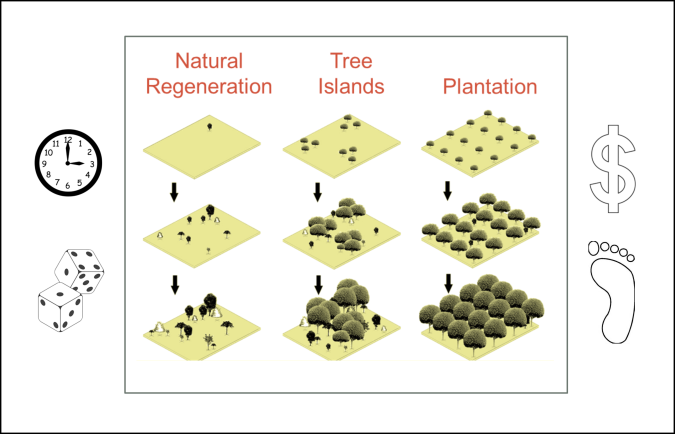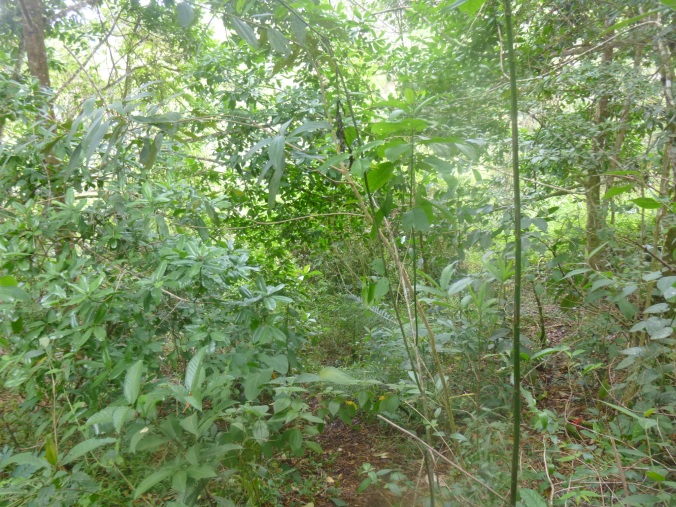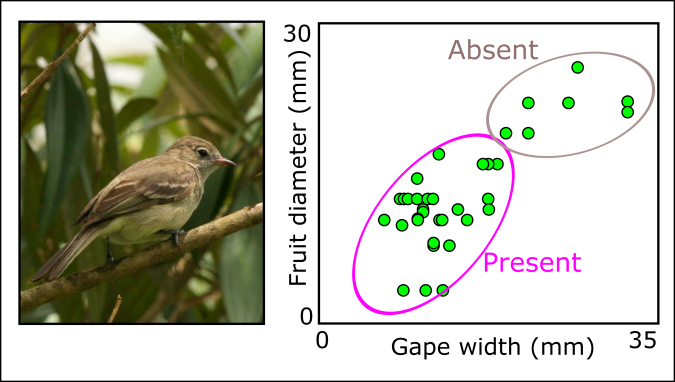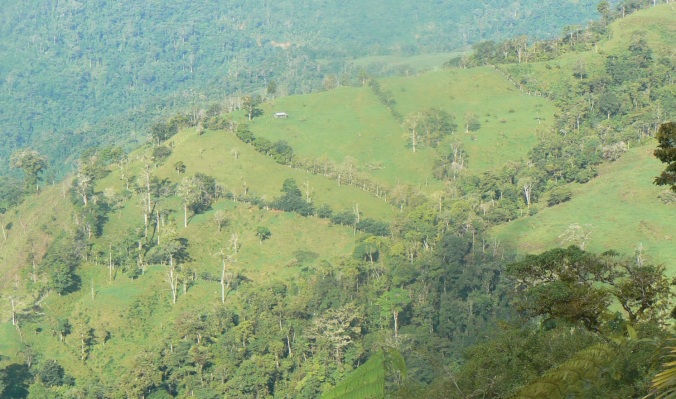Planting tree islands has many of the benefits of larger plantations, but entails significantly less cost. Karen Holl (University of California, Santa Cruz), Leighton Reid (Missouri Botanical Garden), and Zak Zahawi (American University of Beirut) describe recent findings on tree seedling recruitment in a long-term experiment in southern Costa Rica.
Over the past few years there have been a growing number of commitments at the global, national and regional scale to restore forests because of their importance to conserve biodiversity, sequester carbon, reduce erosion, and provide goods and services to people. For example, Initiative 20×20, led by the International Union for the Conservation of Nature, aims to restore 20 million hectares of tropical forest by 2020, an area roughly equivalent to the size of Uruguay or Nebraska.
A common strategy to restore forests is to plant trees. But, the big question is: where will the money come from to plant billions of trees when there are so many pressing needs? As restoration ecologists, we started thinking about how we could most efficiently allocate resources to get the best bang for the buck and restore the largest area of forest.

Trade-offs in forest restoration strategies. Planting fewer trees leaves more to chance and can require more time, but tree plantations are more expensive and leave a bigger ecological footprint. Our study tests an intermediate option, and after 10 years it appears to provide a good balance. Figure modified from Corbin & Holl (2012).
Starting over 10 years ago, we set up a large-scale tropical forest restoration experiment in southern Costa Rica to test two ideas.
First, we tried planting tree “islands”. The idea is to plant groups of trees that attract birds and bats, which disperse most tropical forest tree seeds. The tree canopy also shades out light-demanding grasses that can outcompete tree seedlings. In one experimental treatment, we planted tree islands that covered about 20% of 50 × 50 m plot of former cattle pasture. We compared that to plots where no trees were planted (natural recovery) and to the more intensive (and more typical) restoration strategy of planting trees in rows throughout the plot (plantation).
Second, we asked: is it only possible to restore forest near remnant forests or can you restore forest anywhere in the landscape? This is important information to help guide forest restoration efforts. To do this we set up our entire experiment at 13 sites, some of which were mostly surrounded by agricultural land and some of which were adjacent to the largest remaining forests in the region.
Then we monitored establishment of new tree seedlings in our research plots over a decade. We compared the number of seedlings, number of species, and types of species in the restoration plots with those found in the nearby forest to evaluate how well the forest is recovering.
The tree island planting method not only saves money on buying, planting, and maintaining seedlings, but it also results in a more heterogeneous distribution of trees, so it looks more like a natural forest.

Profuse tree seedling and sapling recruitment in the understory between two tree islands in southern Costa Rica.
We counted over 6000 tree seedlings, 88% of which have seeds that are dispersed by animals. On average there were many more tree seedlings in the tree island and plantation treatments than in the natural recovery plots. These results suggests that some tree planting helps the forest to recover faster, but that it is not necessary to plant the whole area with trees. The tree island planting method not only saves money on buying, planting, and maintaining seedlings, but it also results in a more heterogeneous distribution of trees, so it looks more like a natural forest.
Even though there were many tree seedlings in the island and plantation plots, on average there were less seedlings of tree species that have big seeds (>0.5 cm/0.2 inches across) compared to mature, reference forests. It seems that the larger-seeded species that are common in mature forests are much slower to colonize restored sites, likely because they are eaten and dispersed by a small number of larger animals, such trogons and agoutis. Many of those dispersers are less likely to visit early successional forest.

Small frugivores, small seeds. Most of the birds we see in these experimental plots are small-gaped omnivores (e.g., Yellow-bellied Elaenia, Elaenia flavogaster, left), but it usually takes large-gaped species to disperse larger seeds1. The figure at right shows the maximum fruit size that a bird species with a given gape size was able to consume in a cloud forest in central Costa Rica (modified from Wheelwright (1985)). In our experiment, small seeds were ubiquitous, but large seeds were mostly absent.
We were surprised that the amount of forest cover around the experimental plots had a weak effect on the number of seedlings establishing. In other words, isolated plots had just as many tree seedlings as plots right next to old-growth forests. We think that this is likely due to the fact that there are many trees in the agricultural landscape surrounding our plots; these trees include remnant trees, living fence rows, and riparian corridors. Trees in the landscape can serve an important role in both providing sources of seeds and stepping stones for the movement of seed-dispersing fauna. We anticipate that having forest nearby will be more important in future years as these forests build up greater diversity of rare, large-seeded species. Nonetheless, our results suggest that there are good prospects for restoring forests in many locations in this landscape.
Our key finding is that planting tree islands can be a cost-effective way to restore tropical forests at our study site in Costa Rica, but we hasten to note that the strategy should be tested in other locations, particularly areas with fewer forest elements in the surrounding countryside. Our study also demonstrates that tropical forests can recover some species quickly but it will take many decades, if ever, for forests to fully recover. So, preserving existing rain forests is critical to conserve biodiversity and the services they provide to people.

Diverse tree cover in an agricultural landscape in southern Costa Rica. Remnant trees in pastures, trees along fence rows, and riparian forests provide important sources of flora and fauna to speed up forest recovery.
1See Melo et al. (2009) for an example to the contrary: small-gaped animals dispersing fairly large fruits and seeds.
Pingback: Tree islands for tropical forest restoration: the outlook is rosy after 10 years – Snapzu Earth
Pingback: Tree islands for tropical forest restoration: the outlook is rosy after 10 years – Snapzu Science
Nucleation plantings are the essence of what we mean by “…assisting the recovery of an ecosystem that was degraded, damaged, or destroyed.” We are not engineering ecosystems as happens in plantation forestry. Instead, nucleation plantings vitalize impaired ecological processes. That’s why this work by Karen Holl and collaborators is critically important. Now, can we do micro-nucleation plantings of large-seeded tree species within nucleation plantings? (Of course we can!)
LikeLiked by 1 person
Thanks for this comment, Andy. I couldn’t agree more!
LikeLike
Pingback: Tree islands for tropical forest restoration: the outlook is rosy after 10 years – The Applied Ecologist's blog
Pingback: Variation in soil microbial communities leads to variation in plant communities – The Applied Ecologist's blog
Pingback: Resilience: advancing a deceptively simple concept – The Applied Ecologist's blog
Pingback: Every restoration is unique – The Applied Ecologist's blog
Pingback: Finding missing branches: Phylogenetic patterns of plant community diversity in restored and remnant tallgrass prairies – The Applied Ecologist's blog
Pingback: A common currency for connecting the goals of restoration: plant traits can help us understand how plant communities form and help ecosystems function – The Applied Ecologist's blog
Pingback: Toward prediction in the restoration of biodiversity – The Applied Ecologist's blog
Pingback: Rules of thumb for tropical forest restoration | Natural History of Ecological Restoration
Pingback: It’s Complicated: Trees and Ecological Restoration – Discover + Share
Pingback: What does the Black-faced Antthrush tell us about tropical forest restoration? | Natural History of Ecological Restoration
Pingback: What can bat poop tell us about past tropical landscapes? | Natural History of Ecological Restoration
Pingback: Finding missing branches: Phylogenetic patterns of plant community diversity in restored and remnant tallgrass prairies – The Applied Ecologist
Pingback: Tree islands for tropical forest restoration: the outlook is rosy after 10 years – The Applied Ecologist